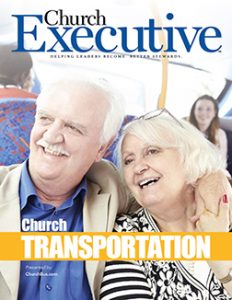Don’t miss the bus
By Mike Jones
 Today’s growing churches are seven-day-a-week operations. The ability to transport worshippers to services on Sunday is just one need; churches are also hosting children, youth and seniors well beyond Sunday.
Today’s growing churches are seven-day-a-week operations. The ability to transport worshippers to services on Sunday is just one need; churches are also hosting children, youth and seniors well beyond Sunday.
So, your transportation needs are clear — and immediate.
Before you buy, here are a few factors about your unique church that should be considered to determine the best overall vehicle investment.
 Church size
Church size
Even if your church is small, it can obtain a church bus! Churches of all sizes use buses. Usually, it just comes down to where you want to put your ministry dollars.
And really, budget can be a factor for any size church. So, look for a dealership that can provide budget-conscious financing or leasing. Leasing a bus is a great way to free up money for ministry and still have a new bus with full manufacturer warranty protection. Generally speaking, the newer the bus, the more reliable it is. However, a slightly used bus can easily fit into your church budget.
Church size might also dictate how large a bus your congregation needs, or how many buses — but not always. Some small churches carry large groups of congregants to conferences and evening services. Likewise, some large churches don’t use any transportation at all.
Daily, weekly and monthly passengers

The number of people a church wants to be able to transport has a lot to do with the size of bus, or number of buses, it will need. In most states, any vehicle that seats 15 or fewer passengers does not require a Commercial Driver’s License, or CDL. A non-CDL bus can make finding drivers much easier for your ministry.
A 26-passenger bus is a very popular mid-size bus among churches. It’s usually equipped for longer trips, offering features to add greater comfort. This size of bus isn’t overwhelming to drive, yet it can carry more passengers while being budget-friendly.
While buses that seat 32 to 52 passengers are available, many churches find the higher price tag to be more than they want to spend. But, if this size of bus makes the most sense for your ministry, consider a lease. Your church’s needs might change, and this ensures you’re not locked into the bus for the long-term.
Service areas — local, regional and national
Service is always an important consideration! Although churches generally put minimal miles on a bus, these vehicles still require regular oil changes, tire rotation and brake service. Most service and warranty work can be done at a local Ford or Chevy dealership, since most buses are built on that brand of chassis. Be sure to partner with a bus company that will be your advocate should any service or warranty work be needed.
Desired options
A variety of options can be on a bus or added: LED lighting; standard seat belts; retractable seat belts; dual hand rails at entry; overhead luggage (for small suitcases or backpacks); reading lights; aisle sliders (allows aisle seats to slide into aisle for more room); DVD player with screens that everyone except the driver can see; back-up camera; navigation system; PA system; AM/FM/CD player; trailer hitch; stainless steel wheel inserts.
Some dealers (ours among them) make a lot of these options standard on church buses — and even take it a step further. For example, we realized that passengers weren’t closing their windows properly. So, when the bus was parked after use, rain came in the bus and damaged walls and floors. It even allowed birds, bees and wasps to get in and nest! So, we felt it best to spend the extra money for a solid window that eliminates the possibility of leaving the windows open. As an added benefit, we find kids can’t put their arms and hands out the windows.
Also available are upgraded seat belts. When not in use, they retract instead of lying on the floor, where people can step on them or get them wet or dirty.
Adding these features will add to the cost of the bus, but some dealers have some — or all — added to their stock buses, saving your church some money.
What about accessibility?
Most buses are easy to access for all ages. Generally, the first step is only about 12 inches high. If you pull up to a curb, the step is even lower.
For seniors, dual handrails are helpful. And, most prefer riding in a shuttle bus than in a van, given the ease of entry and room to maneuver.
Many churches opt for a bus with a lift for optimal inclusion. This helps individuals using walkers or wheel chairs easily board and de-board.
Fuel efficiency
Most gas-powered buses get 10 to 12 miles per gallon. We don’t consider alternate fuels a viable solution for the church market yet, cost- and payback-wise, given the comparatively low miles they run.
Parking
Be sure to plan where the bus will be parked — in a garage or outside. If it’s outside, you’ll want to park the vehicle in a well-lit area that’s as visible as possible from the road.
As with everything you do as church executives, good stewardship of funds is a top priority — not only during the transportation selection process, but on a long-term-maintenance basis. Keep these deciding factors in mind before you sign on the dotted line.
Mike Jones is National Sales Manager at ChurchBus.com.



Great article very informative I was wondering if you are have a monthly magazine that I can subscribe to